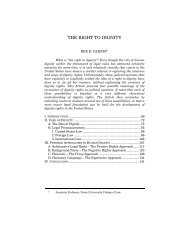A Right to Media? Lorie M. Graham - Columbia Law School
A Right to Media? Lorie M. Graham - Columbia Law School
A Right to Media? Lorie M. Graham - Columbia Law School
You also want an ePaper? Increase the reach of your titles
YUMPU automatically turns print PDFs into web optimized ePapers that Google loves.
452 COLUMBIA HUMAN RIGHTS LAW REVIEW [41:429<br />
ethnical [sic] groups.” 84 Moreover, Article 4 of the Race Convention<br />
(similar <strong>to</strong> the ICCPR) requires states <strong>to</strong> condemn all propaganda<br />
and all organizations which are based on ideas or theories of<br />
superiority of one race or group of persons of one color or ethnic<br />
origin, or which attempt <strong>to</strong> justify or promote racial hatred and<br />
discrimination in any form, and undertake <strong>to</strong> adopt immediate and<br />
positive measures designed <strong>to</strong> eradicate all incitement <strong>to</strong>, or acts of,<br />
such discrimination. 85<br />
Thus, Articles 4, 5, and 7 of the Race Convention impose<br />
certain duties on states <strong>to</strong> adopt measures that ensure against<br />
prejudice and discrimination in the seeking, receiving and imparting<br />
of information. These provisions carry particular relevance in the<br />
context of indigenous peoples, given their unique his<strong>to</strong>rical and<br />
contemporary circumstances. 86 In order <strong>to</strong> ensure that indigenous<br />
peoples can exercise their fundamental rights <strong>to</strong> non-discrimination,<br />
the Committee has called upon State parties <strong>to</strong>:<br />
(a) Recognize and respect indigenous distinct culture,<br />
his<strong>to</strong>ry, language and way of life as an enrichment of the<br />
State’s cultural identity and <strong>to</strong> promote its preservation;<br />
(b) Ensure that members of indigenous peoples are free and<br />
equal in dignity and rights and free from any<br />
discrimination, in particular that based on indigenous<br />
origin or identity . . . . ;<br />
84. United Nations International Convention on the Elimination of All<br />
Forms of Racial Discrimination, opened for signature Mar. 7, 1966, art. 7, S. Exec.<br />
Doc. C, 95-2, at 5 (1978), 660 U.N.T.S 195, 222 (entered in<strong>to</strong> force Jan. 4, 1969)<br />
[hereinafter CERD]. The later part of Article 7 is similar <strong>to</strong> Article 8 of the<br />
Declaration on the Elimination of All Forms of Racial Discrimination and applies<br />
unambiguous language <strong>to</strong> the responsibility of States <strong>to</strong> affirmatively act <strong>to</strong><br />
eradicate discrimination. Declaration on the Elimination of All Forms of Racial<br />
Discrimination, G.A. Res. 1904 (XVIII) art. 8, U.N. Doc. A/RES/18/1904 (Nov. 20,<br />
1963).<br />
85. CERD, supra note 84, art. 4.<br />
86. As one recent Australian NGO report <strong>to</strong> the Committee on the<br />
Elimination of Racial Discrimination notes, “media plays a central role in the<br />
vilification of Indigenous people, particularly through gross sensationalism,<br />
emotive use of language, and use of selective images . . . . ” National Human<br />
<strong>Right</strong>s Network of the National Association of Community Legal Centres,<br />
Australian Non-governmental Organisations’ Submission <strong>to</strong> the Committee on<br />
the Elimination of Racial Discrimination 25 (2005), available at<br />
http://www.fecca.org.au/Submissions/2005/Submissions_2005001.pdf.















